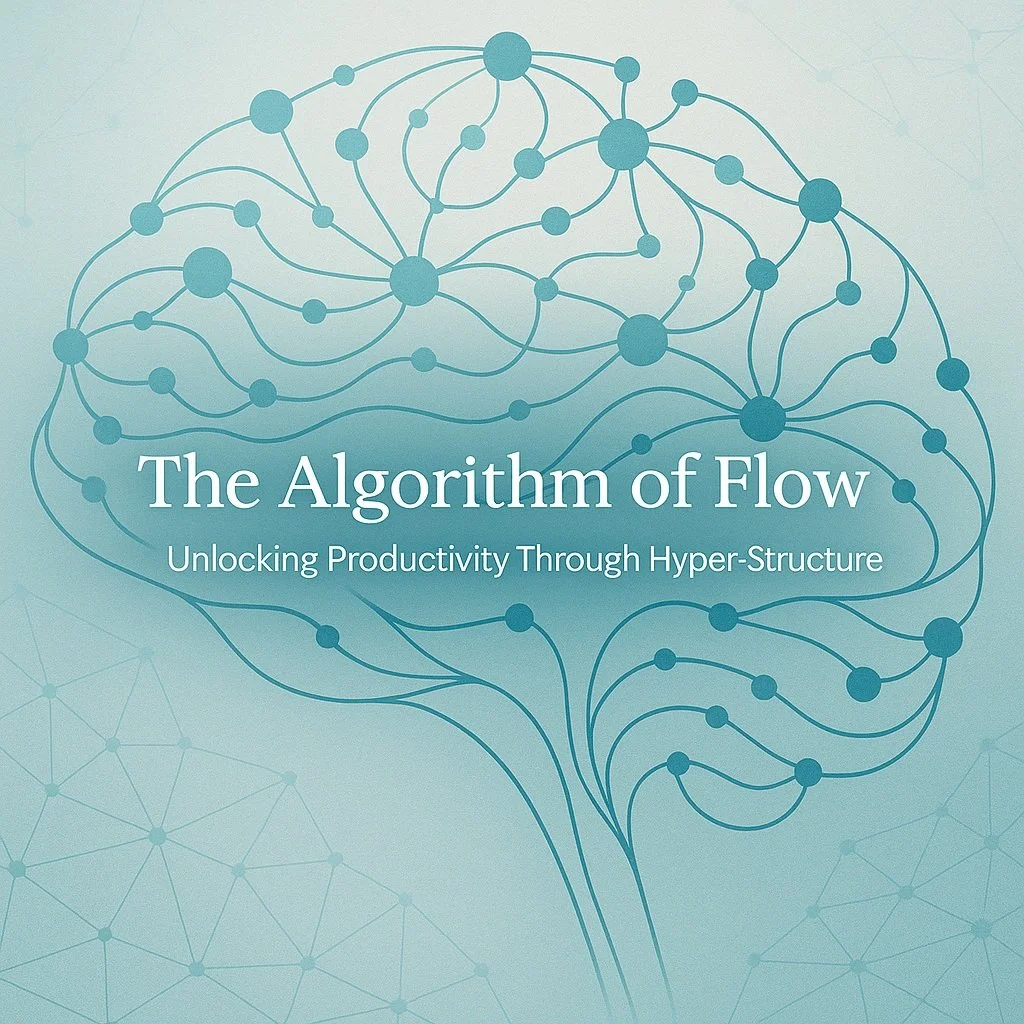The Algorithm of Flow: Unlocking Productivity Through Hyper-Structure
For years, (okay, decades), I tried to follow countless systems presented by others. I built lists, set timers, downloaded apps. I chased the feeling of consistency, but every system collapsed under the weight of my own wiring.
It wasn’t laziness or lack of motivation—it was architecture.
My Autistic and ADHD brain wasn’t built for linearity or vague motivation. It craved logic, sequence, and pattern recognition—the kind of deep, structured, personalized order that most systems overlook.
So, I stopped trying to fit my brain into other people’s moulds, and I started building my own.
That’s how the Algorithm of Flow was born.
Every routine, every transition, every energy dip is a variable. The goal isn’t rigid perfection; it’s creating optimal conditions for flow to happen naturally, predictably, and sustainably—where friction is minimized and joy is coded right into the system.
Phase I: The Anchor and the Initial Conditions
To optimize a system, you must consider the initial conditions that constrain that system. In life, these are biological and hormonal.
Input 1: Wake Anchor (6:00AM – 7:00 AM)
This isn’t a preference—it’s an operating-system load sequence. By waking within a consistent 60-minute window, my body regulates cortisol and melatonin, which keeps circadian rhythms and mood stable.
Next, five to ten minutes of sunlight exposure immediately after waking acts like a biological “on” button, cueing the hypothalamus to start the day’s hormonal cascade.
After that, a quick power-up: chug a full glass of H₂O & take supplements. Simple, mechanical, low-effort—a frictionless win that tells my brain, we’re online. Hydration flushes lingering sleep hormones and begins the metabolic ramp-up for focus.
Flow doesn’t start with ambition; it starts with calibration. This low-effort routine immediately creates positive momentum.
Phase II: The Flow State Mechanics
Most schedules fail because they assume every hour holds the same value. But for most people, energy is dynamic. For some, a “focus block” at 9 AM might feel impossible, while one at 3 PM feels effortless.
Instead of fighting time, I learned to map it. I build my day around State-Matching, not clock-watching.
Everyone’s map should be individually developed based on their own biology, but to give you an idea, here’s a sample map from my day:
6:00 – 7:00 AM | Ground & Align
No output expectations—only stability. I have a cup of tea, journal, stretch. I write if I feel like it, which I often do, but the pressure is not on. These rituals regulate the nervous system, turning chaos into calm readiness.
7:00 – 8:30 AM | Family Prep
I focus strictly on getting my kids ready for school. Making breakfast, light chatter, all that good stuff.
8:30 – 10:00 AM | Work Focus Block 1
Deep, substantive work.
The day continues through three major work focus blocks, each separated by what I call Cognitive Debugging Scripts—short, timed physical resets like a five-minute walk or a slow coffee ritual. These aren’t “breaks”; they’re deliberate state changes.
When you’re in deep focus, switching contexts burns enormous mental energy. The walk or stretch flushes the cognitive cache, resets working memory, and prevents decision fatigue later. Coding these checkpoints into my schedule eliminates the micro-burnouts that can derail you for days.
Phase III: The Buffer and the Boundary
The biggest enemy of flow is the Context-Switch Tax—that hidden cost each time the brain jumps from one task type to another. Perfectionism is its accomplice; together, they create invisible drag.
By afternoon, I shift from optimization to protection.
The Gatekeeper Hour (4:00 – 5:00 PM)
This is not free time—it’s a System Boundary. During this hour, I set the following rules:
no emotional discussions
no new commitments; they get scheduled in my to-do list
no decisions requiring empathy or negotiation.
I set these conditions because by 4 PM, my cognitive fuel is predictably low. Rather than fighting it, I shift into Admin Mode—a low-stakes environment built for order, not invention. I reset the creative chaos that I’ve allowed to unfold during flow: labelling files, tidying my workspace, batching notes for tomorrow, and letting perfectionism have its sandbox. If it wants to nitpick, it can do so here, safely contained.
This is energy logic in motion—the kind that prevents the late-day crash.
Phase IV: The Isolation Protocol (The Distraction Firewall)
Life doesn’t stop when work does. But transition too abruptly, you risk frying the brain.
So, I built a Distraction Firewall—a rule set that delays high-friction tasks until my brain can process them cleanly.
5 – 6 PM: Chill. This is true decompression—a buffer between work and home life.
6 – 8 PM: Dinner, clean up, and family time.
The delay between work and parent mode isn’t laziness; it’s optimization. Jumping straight from performance to presence crashes my cognitive system. By spacing them out, I protect both productivity and peace.
Phase V: The Systemized Shutdown (The Recovery Zone)
The final hours of the day aren’t a cooldown—they’re a controlled descent.
Hyperfocus doesn’t switch off on command.
You can’t “just relax.”
You have to engineer the shutdown.
9 - 10 PM: Self-care—shower, bath, low-stim TV, whatever restores sensory balance.
10 PM: Screens off.
And, of course, the Spellbreaker Formula:
Book + Blanket Cocoon + Water
It’s sensory math—deep pressure for safety, hydration for reset, quiet entertainment for closure. This sequence breaks the optimization loop in my brain and ends the system’s daily cycle.
Rest isn’t optional; it’s written into the code.
A Final Note on Rigidity
Because I don’t live by the minute. Life is dynamic—and my system has to be, too. Having a schedule isn’t a ride-or-die commitment; it’s a recalibration tool. It gives me a clear path to return to when chaos hits, helps me anticipate what’s next, and lets me choose the right time for the right task.
If I’m in deep flow at 10 AM, I don’t stop for a scheduled coffee just because the clock says so. I keep going until I hit that logical breakpoint—the moment the system tells me to breathe.
The structure exists not to confine me, but to catch me. It’s what keeps me from spiralling into the ADHD question of the century: “What am I supposed to be doing right now?”
(Organized hit lists are critical for this too—but that’s a whole other post.)
Solving Your Own Algorithm
Having a system in place moves decisions out of the moment so the process can manage chaos while you enjoy the flow. So, if your day constantly runs away from you, stop trying to be more flexible. Start thinking like an engineer.
Map your biological anchors.
Identify your energy fluctuations.
Write your own code for calm and control.
The Algorithm of Flow isn’t a template—it’s a mindset. It removes self-judgment from the productivity equation and replaces it with logic, compassion, and design.
If you enjoyed this post and would like to hear more about this system and how to start creating your own, let me know in the comments!































For decades, I lived inside a storm I couldn’t name. A restless mind. A body always braced. A heart that felt heavier than it should. I blamed myself. I blamed circumstances. I worked harder, tried harder, forced myself into routines that never stuck. I spent years believing I was simply too much and not enough at the same time.
Then, a diagnosis reframed everything.